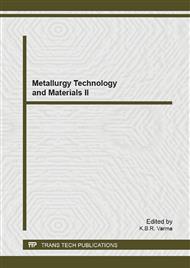[1]
S. Miyazaki, K. Otsuka, Metal. Trans. A 17A (1986) 53-63.
Google Scholar
[2]
M. Paryab, A. Nasr, O. Bayat, V. Abouei, A. Eshraghi, MjoM 16(2) (2010) 123-131.
Google Scholar
[3]
Z. He and M. Liu, Mater. Sci. Eng. B 117 (2012) 986-991.
Google Scholar
[4]
L.P. Chen, N.C. Si, Journal of Alloys and Compounds 448 (2008) 219–222.
Google Scholar
[5]
R.A.A. Aguiar, M.A. Savi, P.M.C.L. Pacheco, Smart Mater. Struct. 19 (2010) 1–9.
Google Scholar
[6]
Y. Soga, H. Doi, T. Yoneyama, Materials in Medicine 11 (2000) 695–700.
Google Scholar
[7]
D. Chrobak, D. Stroz˙ , Scripta Materialia 52 (2005) 575–760.
Google Scholar
[8]
R.R. Adharapurapu, K.S. Vecchio, Experimental Mechanics 47 (2007) 365–371.
Google Scholar
[9]
Q. Wang, Z. He, Y. Wang, J. Yang, Acta Metallurgica Sinica 46 (2010) 800–804.
Google Scholar
[10]
V.N. Khachin, V.E. Gunther, V.P. Sivokha, A.S. Savvinov, Proc. of ICOMAT-79 (1979) 474-479.
Google Scholar
[11]
H.C. Ling and R. Kaplow, Metall. Trans. A 11A (1980) 77-83.
Google Scholar
[12]
J. Uchil, K. Ganesh Kumara, K.K. Mahesh, Mater. Sci. Eng. A 332 (2002) 25–28.
Google Scholar
[13]
X. Ren, N. Miura, J. Zhang, K. Otsuka, M. Koiwa, T. Suzuki, Mater. Sci. Eng. A 312 (2001) 196–206.
Google Scholar
[14]
J. Khalil Allafi, X. Ren, G. Eggeler, Acta Mater. 50 (2002) 793.
Google Scholar
[15]
F. Jiang, Y. Liu, H. Yang, L. Li, Y. Zheng, Acta Mater. 57 (2009) 4773–4781.
Google Scholar
[16]
M.E. Mitwally, M. Farag, Mater. Sci. Eng. A. 519 (2009) 155–166.
Google Scholar
[17]
H.C. Lin and S.K. Wu, Acta Metall Et Mater 41(5) 1994 1623-30.
Google Scholar
[18]
B.D. Cullity, S.R. Stock, Elements of X-ray Diffraction, Prentice-Hall Inc., New Jersey, (2001).
Google Scholar
[19]
P. Filtp and K. Mazanec, Scripta Metall. Mater, 32(9) (1995) 1375-1380.
Google Scholar
[20]
H.C. Lin, S.K. Wu, T.S. Chou, H.P. Kao, Acta Metall. Mater. 39 (1991) 2069–(2080).
Google Scholar
[21]
H.C. Lin, S.K. Wu, Metall. Trans. A 24 (1993) 293–299.
Google Scholar
[22]
W.C. Crone, D. Wu, J.H. Perepezko, Mater. Sci. Eng. A 375–377 (2004) 1177–1181.
Google Scholar
[23]
K. Otsuka, X. Ren, Progress in Mater Sci 50 (2005) 511-678.
Google Scholar
[24]
Y. Liu, V. Humbeeck V, R. Stalmans, L. Delaey, J Alloys Compounds 247 (1) 1997 115-21.
Google Scholar


